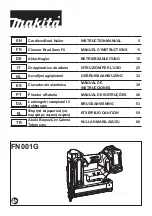
SKU 66995
For technical questions, please call 1-800-444-3353.
Page 9
6. Turn on the air compressor according
to the manufacturer’s directions and
allow it to build up pressure until it
cycles off.
7. Adjust the air compressor’s output
regulator so that the air output is
enough to properly power the tool,
but the output will not exceed the
tool’s maximum air pressure at any
time. Adjust the pressure gradually,
while checking the air output gauge
to set the right pressure range.
8. The air pressure setting must not ex-
ceed job site regulations/restrictions
or exceed max. 90 PSI.
9. Inspect the air connections for leaks.
Repair any leaks found.
10. If the tool will not be used at this
time, turn off and detach the air sup-
ply, safely discharge any residual air
pressure, and release the trigger to
prevent accidental operation.
Note:
Residual air pressure should not be
present after the tool is disconnected
from the air supply. However, it is a
good safety measure to attempt to
discharge the tool in a safe fashion
after disconnecting to ensure that the
tool is disconnected and unpowered.
OPERATING INSTRUCTIONS
Read the ENTIRE IMPORTANT
SAFETY INFORMATION
section at the beginning of this
manual including all text under
subheadings therein before set
up or use of this product.
Inspect tool before use, looking
for damaged, loose, and
missing parts. If any problems
are found, do not use tool until
repaired.
Work Piece and Work Area Set Up
1. Designate a work area that is clean
and well-lit. The work area must not
allow access by children or pets to
prevent injury and distraction.
2. Route the air hose along a safe route
to reach the work area without creat-
ing a tripping hazard or exposing the
air hose to possible damage. The air
hose must be long enough to reach
the work area with enough extra
length to allow free movement while
working.
3. Secure loose workpieces using a vise
or clamps (not included) to prevent
movement while working.
4. There must not be hazardous ob-
jects (such as utility lines or foreign
objects) nearby that will present a
hazard while working.
Single Sequential Safety Trip
Mechanism Definition
This tool has a single sequential safe-
ty trip mechanism, which is designed to
prevent inadvertent firing. The tool should
only fire if the Safety Nosepiece is pressed
against the workpiece prior to pulling the
Trigger. It should only fire again if the trig-
ger is released first. The Tool should not
fire if the Safety Nosepiece is not pressed
against the workpiece.


































